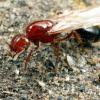Yesterday we had a good 20 minute rain shower. Nothing too heavy. The weather was nice, calm, and humid so I decided to go to my local park/golf course to look for ants (which I've never gone before to look for ants, strangely).
Anyway, on the outskirts of the park there's a bunch of desert (surprise!) and I stumbled across this ~50yd stretch that was full of Veromessor pergandei. I found a couple nests that had midden piles a good ~2ft in diameter, even after the rain we had flushed some of it away. There was, I would say, thousands of them foraging in total throughout that stretch of desert coming from about 6-8 different nest sites. By the way, I was hopping around trying to not have them crawling up my leg. These guys don't form nice neat foraging lines. It feels like they fan out 360 degrees, and they were EVERYWHERE.
I then came across 2 nests that are probably ~20ft away from each other and the inhabitants of said nests looked like they were fighting. Dozens upon dozens of groups of 3-4 of them would look like they were sizing each other up whilst you had dozens of 1 on 1 tackle fights. None of it looked that serious so I'm unsure if any colony had the intention of raiding the other one because it didn't seem like an assault but just a case of too many foragers coming into contact after a big rain. It was a cool site to see for sure.
If I'm not mistaken Veromessor pergandei are able to form super colonies in the wild?
One more thing that I got excited about was that I came into contact with about 5 workers of Odontomachus clarus. I was pumped because I've never seen trap jaw ants before. Unfortunately, I wasn't able to locate the nest site though. It threw me off how big they were. Biggest ant I've seen around here by far. Veromessor p. held that title before. Definitely a pretty species. I must get my hands on some queens! Anyone here know if trap jaws are high or low maintenance?
















